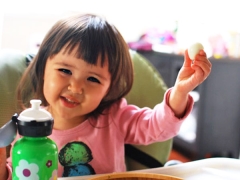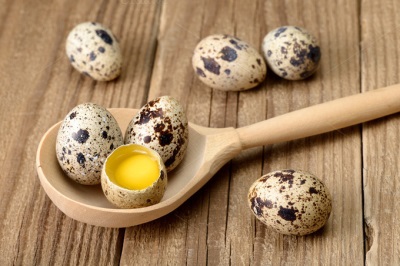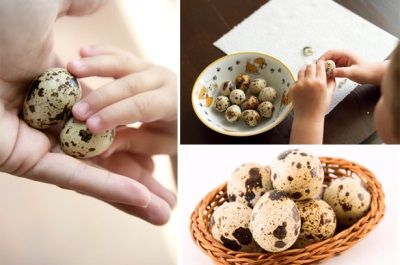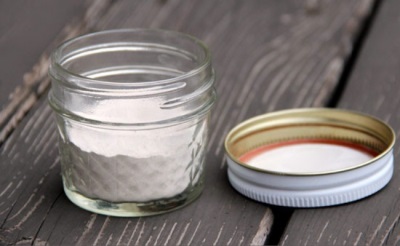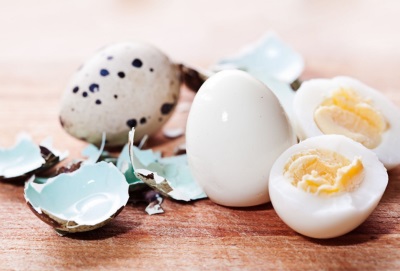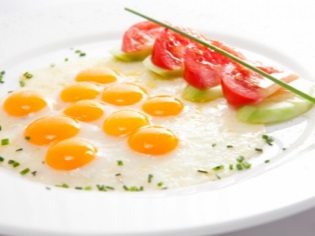Is it possible to give a child quail eggs, how to boil them and from what age to put in complementary foods?
Egg is one of the main products in baby food, so it is introduced into the diet of babies before the year. However, many parents have heard that quail eggs are more useful than chicken. Is this true, do they have harmful properties, when can they be given to a baby and how to cook? Let's figure it out.
Benefit
- Although the weight of a quail egg is not very large (on average it is 10 grams), such a product is rich in a large number of useful substances. Among them, beta-carotene, calcium, vitamin A, magnesium, sulfur, vitamin D, sodium, B vitamins, potassium, and many other compounds. The content of some of them is much higher than that of chicken eggs.
- Like other eggs, quail gives the baby a valuable amino acid. They are rich in lysine, cysteine, tryptophan, glutamic and aspartic acid.
- They note the properties to improve digestive function, increase the level of hemoglobin, strengthen the nervous system, bones, eyesight. In addition, the product has the ability to increase the body's defenses. They are advised in case of mass deficiencies and frequent illnesses.
- Due to the smaller size, it is more convenient to introduce them into the baby’s diet. This product stays fresh longer and is well stored. In addition, children like their colorful look and tiny size.
- In a child with a chicken egg allergy, the introduction of quail eggs into the diet may not cause an allergic reaction.
In general, there is no fundamental difference in the benefits of chicken and quail eggs. Watch about this video of Dr. Komarovsky.
Harm and contraindications
- Since the cost of quail eggs is higher, they may lie longer in the store, so there is a risk of acquiring a stale old product. You should carefully look at the expiration dates and buy such eggs in the checked places.
- Due to the thin shell and variegated appearance, you can overlook the damage and prepare the spoiled product for the child. Be sure to inspect the product before cooking and do not buy too light or shiny eggs. You can also check them by dropping into the water - a fresh egg will sink to the bottom of the tank, and the stale ones will float on the surface.
- Although quite rare, they can cause allergies and salmonellosis. To prevent these problems, they should be introduced into the infant diet gradually, and you should not give them to the child raw.
Is there an allergy?
Hypoallergenicity is one of the differences between quail eggs and chickens, as they contain ovomucoid, which, compared to other proteins, causes allergy much less frequently. However, there are still cases of an allergic reaction, so with the introduction of such a product into the diet one should be as careful as with acquaintance with any other unfamiliar baby dish.
Is it possible to eat raw?
You can often hear the recommendation to use them raw, since this product, compared to eggs from domestic chickens, is practically not dangerous in terms of the development of salmonellosis. However, doctors advise not to give eggs to children who have not undergone heat treatment for such reasons:
- Through quail eggs, a child may become infected with another intestinal infection, pullorosis.
- Crude protein is digested longer, and can also cause flatulence and indigestion.
- Many children do not like the taste of raw eggs.
Giving a raw quail egg to a baby or not should be decided by parents, but if they intend to do this, sufficient attention should be paid to washing the shell (it should be thoroughly washed with soap).
From how many months can you put in feed?
For the first time, a quail egg can be given to a breastfed baby at 9 months of age, and the baby-artillery - a month or two earlier. Note that we are talking about the introduction of only the yolk.
First, the child should try only a small grain of boiled yolk, and only in the absence of a negative reaction to such a product can it be increased to 1/4, then to half and to a year to a whole yolk. Most often, the crushed yolk is added to porridge or in a dish of vegetables.
After a year, the baby can be introduced to protein. This makes it possible to offer crumbs not only boiled eggs, but omelets, casseroles, pastries, souffles and other dishes, the ingredients of which they are.
Do I need to use powder from the shell?
The shell of quail eggs is rich in calcium, which is easily digested, and also contains fluorine, zinc, copper and other trace elements. Due to this composition, it can serve as an excellent source of these nutrients for the children's body.
In a crushed form, the quail egg shell is recommended to be given for hypovitaminosis, fragility and brittleness of hair and nails, anemia, as well as during puberty.
To make the powder from the shell, it is dipped in vinegar for 2 minutes, then washed under running water and allowed to dry. The shell can simply lie in a dry place or dry in an oven at 200 degrees for about 10 minutes. Next, it remains to grind in a coffee grinder and place in a tightly closed jar.
Such powder is added to small children in food, and an older child is given to drink on an empty stomach, stirred with water and a few drops of lemon juice.
The optimal daily dosage of such a product is called 1/2 teaspoon per 10 kg of child's weight. Give the powder from the shell should be children older than a year and preferably after consulting a doctor.
How to cook?
Cooking quail eggs does not last long due to the small size of the product. It’s enough to boil them for two or three minutes and you will get hard-boiled eggs. In this case, it is worth considering the following nuances:
- First, gently wash them, trying not to damage their fragile shells.
- Dip them not in the boiling, but in cold water, so that they do not burst due to the temperature drop.
- To boil eggs, water must cover them completely.
- A pinch of salt can be added to the water, then the risk of cracking in the shell will decrease.
- When the water starts to boil, set aside time and cook them for no longer than 5 minutes.
- You can get a boiled egg with a slotted spoon or, pour boiling water, pour cold water (then cleaning will be easier).
How many quail eggs per day can you eat?
Babies under 12 months are given only yolks. The limit is one yolk of quail eggs per day. For children older than a year, there are such recommendations for daily consumption of quail eggs:
Age | Permissible number of quail eggs per day |
From 1 to 3 years | 1 piece |
From 4 years to 7 years | 2-3 pieces |
From 8 years to 12 years | 3-4 pieces |
Over 12 years old | 4 pieces |
Many myths are debunked in the program "About the Most Important".
Useful recipes
Eggs for the children's menu can be not only cooked, but also prepared in this way:
- Make an omelet Take 2 quail eggs and a tablespoon of milk. For preschoolers, such an omelet is steamed or baked in the oven, and an older child can be fried. Many kids like omelets with cheese, cottage cheese, vegetables, apples, pasta and other tasty ingredients.
- Fry. In just 7-8 minutes, you can cook a schoolchild with a delicious egg, adding cheese, slices of ham, fresh or boiled vegetables to such a dish.
- To make a sandwich. For a child, such a dish should first be attractive. For example, you can make hares, mice or elephants from cut eggs, by adding carrots, cheese or greens to the base of a boiled egg.
- Make a salad. Prepare children salads from vegetables, the ingredient of which can be a boiled quail egg. Decorate this salad with carved figurines and greens.
- Cook stuffed eggs. Such a dish can both be offered to a baby or made for any holiday. Inside quail eggs can be potato filling, chopped vegetables, broccoli puree, chicken, fish and any other filling to your taste.
